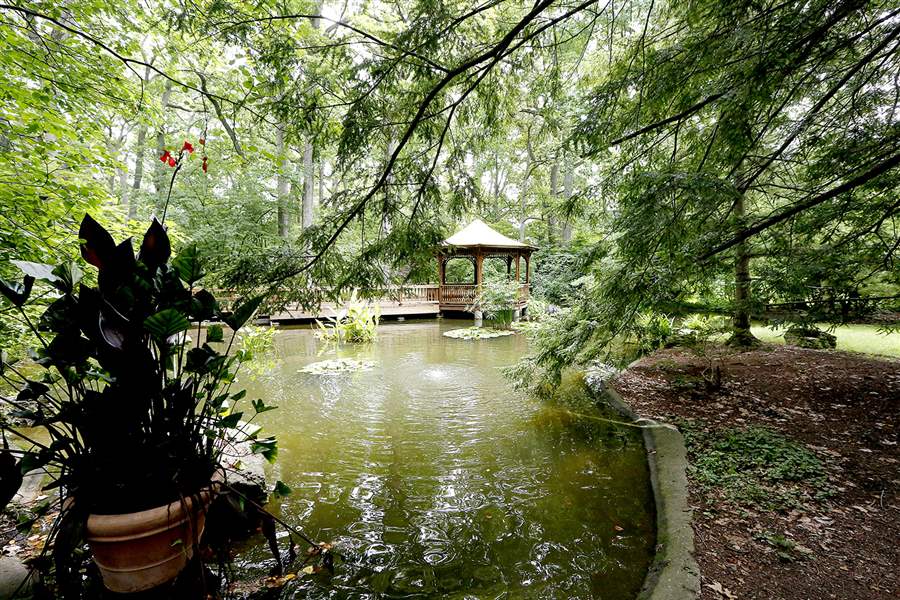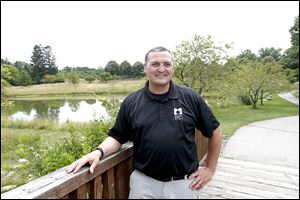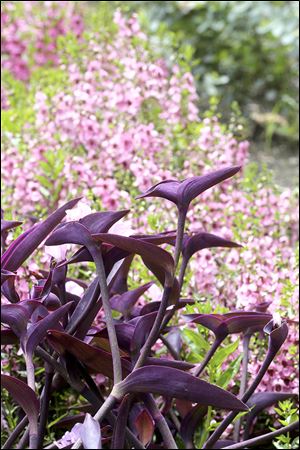
Metroparks takes over Toledo Botanical Garden
8/7/2017

The Toledo Botanical Garden is in full management control by the Metroparks of the Toledo Area. Visitors will see little difference in the operation and associated art and horticultural clubs will continue.
THE BLADE/JETTA FRASER
Buy This Image
A walk through Toledo Botanical Garden shows that little, if anything, has changed since the Metroparks of the Toledo Area took over operations at the West Toledo parklands.
Gardening enthusiasts and botanists flock to the gardens to see one of the country’s largest collection of hostas. They stroll the grounds to admire the explosion of color from the roses, day lilies, dahlias, and perennials thriving in the summer heat.
Brides and grooms pose for photographers in front of the backdrops of manicured hedges, sculptures, and wisteria clinging to trellises in the perennial garden.
Metropark officials, who were handed the keys to the 66-acre park about three weeks ago, said visitors should expect to see subtle changes to the grounds while their organization abides to the Toledo Botanical Garden’s mission of serving as a center for horticulture, the arts, and nature.

The Toledo Botanical Garden is in full management control by the Metroparks of the Toledo Area. Visitors will see little difference in the operation and associated art and horticultural clubs will continue.
RELATED CONTENT: Metroparks to take over city garden ■ Botanical Garden opens children’s Discovery Trail
Dave Zenk, executive director of the Metroparks, said improvements will be designed around getting more people into the new Metropark and increasing its presence among park district facilities.
“We want to add to the horticultural heritage of the site, increase educational opportunities, and raise awareness to expose more people to the garden,” he said. “It’s about giving people some new and different reasons to visit that are non-consumptive and do not take away from the horticultural integrity of the site.”
The botanical garden, at 5403 Elmer Dr. in West Toledo, receives about 150,000 visits annually, according to the TBG website.
“We know from surveys that people have a favorable opinion of TBG. But nearly two-thirds of [the people surveyed ] go there rarely — once a year or less. We plan to keep what people love while adding additional reasons to visit,” Mr. Zenk said.
The botanical garden became an affiliate facility of the Metroparks in 2006 after losing funding from the city of Toledo. It moved under full control of the Metroparks July 15 in an agreement reached between park district commissioners and the non-profit TBG’s board of directors.
TBG is retaining Toledo Grows, a horticulture program fostering community gardens, including the urban farm campus on Oneida Street near downtown Toledo.
Jennifer Scroggs, chairman of the TBG directors, said revenue from fund-raisers, donations, and program fees was not keeping pace with the park’s rising operations and maintenance costs.

Joe Fausnaugh, director of operations for Metroparks, says visitors will soon see updated facilities and walking paths.
“It wasn’t getting any less expensive to maintain. The buildings are aging. The trees are getting older,” she said. “The sustainability of the operations was starting to become difficult.”
The organization’s tax filings for 2015 — the most recent year available — reported nearly $1.5 million in revenue was about $360,000 short of what was needed to meet expenses for the year.
Four TBG employees landed jobs with the Metroparks. Matthew Killam, who was the TBG’s marketing director, is now the Metropark’s marketing director, a new position for the park district. He is being paid $73,000 annually.
Mrs. Scroggs said eight of 30 workers were asked to stay with TBG to work in the Toledo Grows operation. She said Karen Ranny Wolkins, TBG executive director, was not offered a position with Toledo Grows or the Metroparks.
Those landing full-time jobs with the park district are Doug Conley, horticultural services supervisor, who is being paid $60,320 a year; Sanja Jennings, horticultural technician, at $15.11 an hour, and Jonathan Milbrodt, who is being paid $18.44 hourly to be the Metroparks’ lead horticulturist. Also, four additional TBG workers joined the Metroparks’ seasonal staff.
The TBG board will continue to host annual fund-raisers, including the Crosby Festival of the Arts and Jazz in the Garden. The board will dedicate proceeds to fund Toledo Grows, which has raised thousands of pounds of food in 126 community gardens cared for by neighborhood residents, churches, school groups, and community centers.
The garden’s 52-year-history began when the city of Toledo accepted the donation of 20 acres from the estate of George P. Crosby, a commercial real estate broker who died in 1963. Mr. Crosby kept horses in a stable on the property, which was then part of Adams Township.
Mr. Crosby wished his horse farm would be used as a “public park and playground.” The late Richard Boers, a longtime Toledo forestry commissioner, is credited for developing the rolling farm with trees and stream into a botanical garden, which was announced in 1965.

Metroparks of the Toledo Area hopes to increase the number of visitors to the Toledo Botanical Garden.
Early plans for “George P. Crosby Gardens” included a conservatory for exhibits and plant propagation; an education building for laboratories, workshops, classrooms, and meeting rooms; a fragrance and texture garden for the visually impaired; a pond with an overlook, rock garden, and aquatic plants; and a fenced area for visitors to grow their own plants.
Under Mr. Boers’s leadership, the botanical garden — then only about one of 100 in the country — expanded and began to take shape as a nature preserve and garden. The city used U.S. Department of Housing and Urban Development funds to buy 8.5 acres of adjacent land in 1969 and 18 more acres in 1972.
A mayoral-appointed advisory board to oversee the city park was established in 1972, when the first of three master plans was drafted for the facility. Additional property, including houses on Olimphia Road that eventually formed the village for artists and gardeners, was acquired in the early 1970s.
The cottages became home base for clubs dedicated to the hobbies of gardening, painting, pottery, glassblowing, photography, and other arts. The organizations pay rent and utilities, and their members are expected to volunteer in garden activities and offer workshops for park visitors.
By the end of the decade, the garden encompassed nearly 50 acres, stretching from Elmer to Bancoft Street.
The 1980s saw the garden formed into a non-profit with a board of directors. The park was further developed with Crosby Lake, additional gardens, and a maintenance and greenhouse facility.
A new entrance on Bancroft was eventually added. In 1989, city council approved renaming the park Toledo Botanical Garden.
The garden began to rely more on private funds, memberships, donations, plant sales, and other events during the 1990s as city leaders cut funding for parks and programming.
Joseph Fausnaugh, chief of operations for the Metroparks, said work is under way on TBG grounds safety issues, such as fixing and leveling brick paths and modernization of restrooms.
Metropark officials said visitors will eventually see Metropark signage appear and other improvements.
Mr. Fausnaugh said a study of the garden’s 34 buildings and TBG’s operations and services is under way to determine the best use for the structures and what can be removed.
“We are still exploring the property and the laundry list of what the needs are,” he said.
Metropark officials said the long-standing rule that forbids visitors bringing dogs into the gardens is still in place because of its sensitive plant and flower collection.
“For now, the rules that have been in place at TBG are going to stay in place. We really need to understand why they had the rules here and what the opportunities are,” Mr. Fausnaugh said.
Mr. Zenk sat down with Toledo Mayor Paula Hicks-Hudson to talk about the TBG’s ownership three days before the agreement was reached to transfer the garden to the Metroparks. Ownership under the Metroparks umbrella would be important in asking for grants to fund projects, the Metroparks said.
“I have asked the mayor to consider transferring the property to Metroparks because I fully believe what’s best for the community is Metroparks taking ownership of the property,” he said. “To take the Toledo Botanical Garden to national prominence and to invest in the garden the way we envision, we need grant funding and philanthropic support, both of which require that we own the property we are improving.”
Scott Carpenter, Metroparks spokesman, said the 15 resident arts and horticulture organizations headquartered at TBG are integral to the garden and have been asked to remain. The park district will receive the nearly $14,300 annually the groups pay in rent.
Nearly 900 volunteers, including the members of the organizations and clubs and Toledo Grows, contributed about 16,000 hours annually to TBG efforts.
Steve Stalker, of the resident group Photo Arts Club of Toledo, said he sees the new ownership as a positive move for the organization and the gardens because of the resources the Metroparks can provide and the public interest it can generate.
“This is a beautiful park. But I would say that 25 percent of the city doesn’t even know the garden exists. This is a real jewel for the city,” he said.
Contact Mark Reiter at markreiter@theblade.com or 419-724-6199.